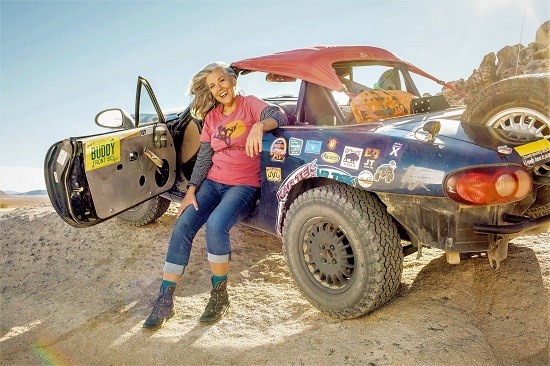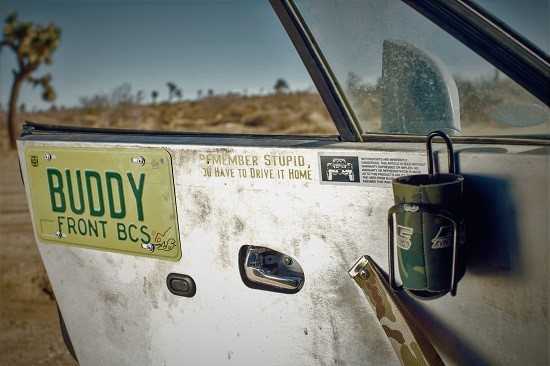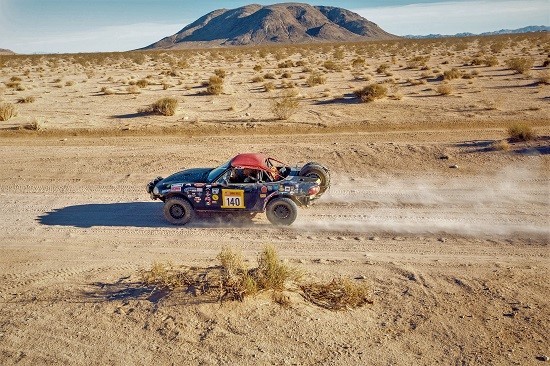Emme
Hall, an auto journalist, loves to go off-roading, and she also loves Buddy,
her 2001
Mazda MX-5 Miata sports car.
اضافة اعلان
Normally these two
loves would be star-crossed, but not in Hall’s case. The Miata (one of two she
owns) is happiest away from the pavement: It’s lifted to give the normally
low-slung roadster 10 inches of ground clearance and has a beefed-up radiator
to cope with hot trail days, a skid plate to protect the vulnerable
undercarriage, a row of rally lights, a skimpy bikini top for sun protection
and huge 27-inch tires. Despite the stock 1.8-liter engine, producing a modest
142 horsepower, it can and does get airborne.
Buddy has more
than 130,000 miles (209,215km) on the odometer. Hall’s day job includes racing
in events like the Baja 1000 and Mint 400 (as well as the Rebelle and Gazelle
rallies), then writing about the experience in outlets like
CNET Roadshow.
Taking Buddy off
the beaten path, even if it results in broken axles, is what she does for fun.
Hall, who lives in Yucca Valley, California, is one of a large group of auto
industry people — executives, analysts, and journalists — who, having driven
everything else, buy and enjoy Mazda Miatas.
 Auto journalist Emme Hall drives her extensively modified 2001 Mazda MX-5 Miata in Yucca Valley, California, on January 11, 2022. (Photo: NYTimes)
Auto journalist Emme Hall drives her extensively modified 2001 Mazda MX-5 Miata in Yucca Valley, California, on January 11, 2022. (Photo: NYTimes)
The little cars
combine affordability with clever engineering, dependability and driving fun,
they say — even at low speeds. Miata values have been rising, too — especially
for the first, so-called NA generation of model years 1990 to 1998 — but hardly
into
Porsche or
Ferrari territory. Classic-car insurer Hagerty estimates that a
fully restored 1990 Miata is worth $29,800.
“The best part of
Buddy is that he makes everyone smile — they leave notes on him when I go for
gas,” said Hall, who also has a 178-horsepower 2004 NB (second-generation)
Mazdaspeed Miata with a turbocharger.
“Miatas are
simple, even the new ones,” she said. “There’s not a lot to interfere with your
driving. I can wind my Miata out just going from one traffic light to another.
Plus, they’re cheap — I don’t like spending a lot of money on a car.”
Hagerty CEO
McKeel Hagerty explained the appeal. “The Miata is the signature car in the recent evolution
of the car world,” he said.
“More than 1
million have been built, and you can track them or just cruise,” he added.
“Miatas offer the best way into vintage racing. They’re incredibly reliable,
and they hold value well.”
Gregor Hembrough,
head of Polestar North America, chose a 2002 Miata as daily transportation when
he worked for Volvo in Goteborg, Sweden, in the early 2000s.
“An MX-5 isn’t the
obvious choice as a daily driver for someone residing in Sweden,” Hembrough
acknowledged. “However, for me, the lure of a pure sports car was too strong to
overcome. For autumn and winter, the car had heated seats, a limited slip
differential, a removable hardtop and studded snow tires.”
 The stripped-down door panel of auto journalist Emme Hall’s extensively modified 2001 Mazda MX-5 Miata in Yucca Valley, California, on January 11, 2022. (Photo: NYTimes)
The stripped-down door panel of auto journalist Emme Hall’s extensively modified 2001 Mazda MX-5 Miata in Yucca Valley, California, on January 11, 2022. (Photo: NYTimes)
He added, “For
spring and summer, I enjoyed countless long evenings with the top down and the
music up. It was a sad day when I returned to the US and the car went on to a
new home.”
Owners tend to
drive their Miatas rather than merely admire them as garage ornaments.
Hembrough put 30,578km on his over three years of ownership.
To relax, Sam
Abuelsamid, principal analyst for e-mobility at Guidehouse Insights in Detroit,
regularly takes out his 1990 Miata — a very early model built in October 1989.
“My dog, Rosie, likes riding in it,” Abuelsamid said. “She’s tall enough to
stick her head out.”
He added, “The
Miata is the definitive example of why it can be more fun to drive a slow car
fast than a fast car slow. Behind the wheel, the Miata is like an extension of
my hands — I can explore its limits and not be at speeds that will get me
thrown in jail.”
Abuelsamid covers
electric, autonomous, and connected cars, and he road-tests the latest models.
To unwind, however, he goes old school, putting the top down and driving to
nowhere in particular for a couple of hours.
Stephanie Brinley,
principal analyst for the Americas in IHS Markit’s automotive division, is on
her second Miata in Troy, Michigan. To tackle Michigan winters, she throws snow
tires on — even putting the top down sometimes if the sun is out.
“My first Miata
was a 1998 I bought gently used with only 1,500 miles (2,414km) on the
odometer,” Brinley said. “I was replacing an Acura Integra GS-R, which is a
pretty sporty car, and I wanted something that would be just as much fun but
still in a reasonable price range. After 15 years, I got tired of having to
take the Miata’s hardtop on and off every year, and bought a 2012 NC with the
power retractable hardtop.”
“It remains the
best bang for your buck,” she added. “The new Corvette is a wonderful machine,
but it’s bigger and more expensive and not as good as the Miata to use as an
everyday car. I always smile when I drive my Miata, even after owning it for
years. It’s such a well-balanced little thing.”
 (Photo: NYTimes)
(Photo: NYTimes)
Chris Nelson, a
former senior editor at Automobile Magazine who now edits Drool (for dog
owners) and Iron & Air (about motorcycles), is an ex-Miata owner. But he
made sure his separation from Gracie, the silver 1991 car he inherited from his
father, was as dramatic as possible.
“It was a nice
car, with the speakers in the headrests that let me listen to books on tape,
and I drove it for 15 years,” said Nelson, who lives in Long Beach, California.
“I loved that car, but I was doing a lot with motorcycles, and I needed a
truck.
“After my father
died, my mom was having a hard time, so when she turned 60 I took her on a
2,000-mile road trip in the Miata around California, from Hermosa Beach up
through Big Sur,” he continued. “Then I pulled off the right front fender and
sent it to a jewelry maker — who made a bracelet and a ring as remembrances for
my mother. Then, in 2018, I found another fender and sold the car.”
Nelson said the
key to the Miata “is the simplicity — cars are so complicated now.”
“The NA epitomized
Japanese design, with minimal obstructions to the sightlines. In the Midwest,
where I’m from, they make fun of the Miata, but they just don’t understand what
makes it great.” While he was at Automobile, a half-dozen other employees owned
Miatas, he said.
Despite liking the
car in bone-stock form, Nelson said the ultimate iteration was a conversion
sporting a small-block V-8 engine, such as a General Motors LS1. “That’s my
dream car,” he said. “It’s the best to drive, and the bigger engine upsets the
weight balance only a little bit.”
After attending
the press introduction of the third-generation NC, Perry Stern, formerly an
editor at MSN Autos and now at AutoNXT, decided he had to own a Miata.
“Ultimately,” he
said, “I convinced my wife I needed something more fuel-efficient than the 2004
Ford Explorer I was driving. I found a used 2006 Miata — the first year of the
NC — with only 47,000 miles (75,639km) in 2014.”
Stern, who lives in
Sammamish, Washington, drives the car sparingly (it’s at 58,700 now), but — you
guessed it — “it still brings a smile every time I take it out for a drive,” he
said. “Even if I’m not driving it, it makes me happy to look in the garage and
see it there. I expect to own it until the day I die.”
Read more Drive



